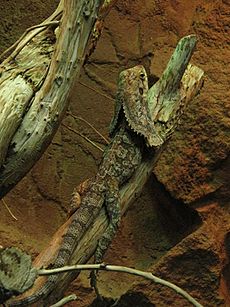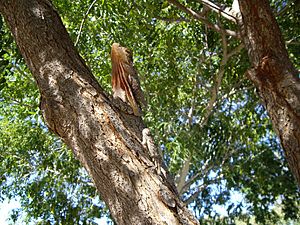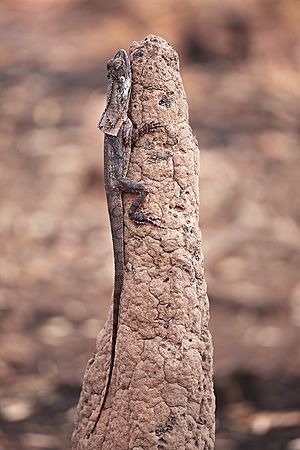Frill-necked lizard facts for kids
Quick facts for kids Frill-necked lizard |
|
|---|---|
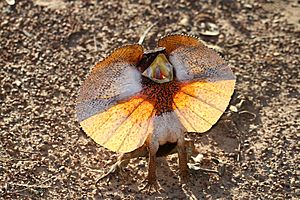 |
|
| Scientific classification | |
| Genus: |
Chlamydosaurus
|
| Species: |
kingii
|
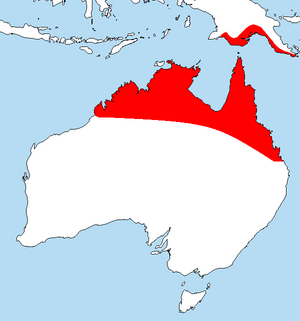 |
|
| Range map of frilled-necked lizard | |
The Frill-necked lizard (Chlamydosaurus kingii) is a fascinating reptile. It has a big, thin frill around its head. When it feels scared, it spreads this frill out to look bigger and scare off enemies. It also opens its mouth wide and sometimes stands up on its back legs. If it needs to escape quickly, this lizard runs away using only its back legs. This speedy escape earned it the nickname "bicycle lizard."
In the Jawoyn language spoken near Katherine, Australia, this lizard is called leliyn.
Contents
What Does the Frill-necked Lizard Look Like?
The frill-necked lizard is a large member of the agamid family. It can grow up to 85 cm (2.79 ft) long. These lizards can walk on two legs, which is called bipedal movement. Naturalists have seen them often moving around with a clear, purposeful stride on their hind legs.
Their skin is usually brown or grey. It has darker spots and blotches that look like tree bark. The color of a frill-necked lizard changes depending on where it lives. For example, a lizard from a dry, clay area might have colors like orange, red, and brown. One from a wet, tropical area will likely be darker brown and grey. This helps them blend into their surroundings, which is a type of camouflage.
The most special part of these lizards is their large frill of skin. It usually stays folded back against their head and neck. This frill is held up by long, thin bones made of cartilage. These bones are connected to the lizard's jaw. When the lizard is scared, it puts on a surprising show called a deimatic display. It opens its mouth wide, showing a bright pink or yellow inside. It also spreads its frill, which has bright orange and red scales. The lizard raises its body and sometimes holds its tail up. This display is used to protect its territory, scare away predators, and during mating season. The red and orange colors in its frill come from special pigments called carotenoids.
The bones that support the frill are special hyoid bones. They form rods that help the frill expand. When the frill is relaxed, it can also help the lizard hide. There isn't one standard color for the lizard's body, but it's usually darker than its frill.
Where Do Frill-necked Lizards Live?
Frill-necked lizards mostly live in northern Australia and southern New Guinea. You might sometimes find them in the lower desert parts of Australia. However, they prefer humid places like tropical savannah woodlands.
These lizards are mostly arboreal, meaning they spend most of their time in trees. They only come down to the ground to find food or to fight over territory. Living in trees helps them find food, as their diet includes small arthropods (like insects) and even smaller vertebrates (like other lizards). But most importantly, trees offer great camouflage for them.
What Do Frill-necked Lizards Eat?
Like many lizards, frill-necked lizards are carnivores, which means they eat meat. They hunt and eat cicadas, beetles, termites, and even mice. They especially love butterflies, moths, and their young (larvae). While insects are their main food, they also eat spiders and sometimes other lizards.
Frill-necked lizards are "ambush hunters." This means they wait quietly for their prey to come close, then they pounce. When they find food, they eat a lot! These big eating times usually happen during the wet season. At these times, they can eat hundreds or thousands of flying ants or termites.
How Do Frill-necked Lizards Control Their Body Temperature?
The frill-necked lizard is ectothermic. This means it relies on its surroundings to control its body temperature. It warms up by basking in the sun for a short time. This helps its body temperature become about 2–3 °C warmer than the air around it. Sunlight and weather conditions are the main things that help them control their temperature. They usually bask in the morning to early afternoon to get the most sun. However, their final body temperature mostly depends on how warm the air is. People once thought the frill helped with temperature control, but this has been found to be untrue.
Who Are the Frill-necked Lizard's Predators?
The main animals that hunt frill-necked lizards are eagles, owls, larger lizards, snakes, dingos, and quolls.
Frill-necked Lizards in Culture
A frill-necked lizard was shown on the back of the Australian 2-cent coin until 1991.
A frill-necked lizard named "Lizzie" was the mascot for the 2000 Summer Paralympic Games.
This lizard is also featured on the emblem of NORFORCE, an Australian Army regiment in Northern Australia.
Because of its unique look and behavior, the frill-necked lizard has often appeared in movies and TV shows. A frill-necked lizard named "Frank" was in the 1990 Disney animated movie The Rescuers Down Under. In the 1993 film Jurassic Park, the dinosaur Dilophosaurus was shown with a neck frill that opened when it attacked. This made frill-necked lizards very popular as pets for a while!
See also
 In Spanish: Clamidosaurio de King para niños
In Spanish: Clamidosaurio de King para niños


